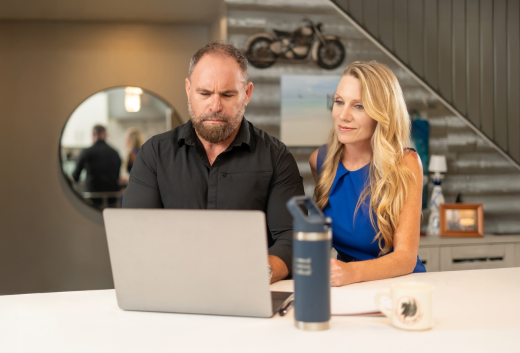Two bits of recent news caught our attention at AAFMAA Mortgage Services LLC (AMS):
- The national credit card balance stands at $1.08 trillion, a record high, with the average interest rate reaching 21%, the highest point recorded by the Federal Reserve in nearly three decades of tracking.
- Home equity rose by $20,000, or 6.8% through the end of Q3 2023 compared with a year earlier. Analysts at Core Logic say that equates to an average of about $300,000 per homeowner based on the purchase timing of their home.
Those seemingly disparate financial situations — unprecedented high-interest credit card debt and solid equity gains — are renewing the popularity of refinances and other loan products that allow the owner to get “cash back” they can use for any purpose, such as consolidating debts to potentially lower monthly payments.
How much you can borrow against your home depends on its value, and the type of loan you have (more on that later). If you own your house outright, you own 100% of its equity or market value. If you have a mortgage, you’ll need to calculate your equity by subtracting everything that’s owed on that property from its market value (that’s how much another buyer would pay for the home). If you’re uncertain of your home’s value, there are a number of online home valuation tools that typically rely on recent sales (or comps) in your area to determine your home’s value. An example includes Zillow’s Zestimate. You could also consult a real estate agent or hire a professional appraiser if you prefer.
Related: Cash-Out Refinance vs HELOC – Which Is Right for Me?
Options for Tapping Your Home's Equity
These products can often save homeowners money now but are primed to get even more popular as interest rates cool, as expected by market watchers like LendingTree, which predicts 30-year fixed mortgage rates could drop to 6% in 2024, and possibly lower before 2025.
There are several loan options for taking equity out of your home, including refinances and seconds, so this would be a good time to engage with us. An AMS Military Mortgage Advisor can look at your home’s value and find out how long you plan to live in the home to make product recommendations that would work best for you.
Cash-Out Refinances
If you purchased your home in the past 18 months — when rates hovered around 7% — you might be able to refinance in the coming year to a lower interest rate (lowering your monthly payments) and take cash out.
A cash-out refinance replaces your current loan and gets you money back while leaving some equity in the home. The exact amount depends on the type of loan you’re using. With a conventional loan, you need to leave 15–20% equity in your home. FHA loans allow you to leave just 15% equity, but you’ll have to pay mortgage insurance premiums. Finally, if you’re an eligible active-duty servicemember, Veteran or surviving spouse, you may be able to refinance your VA Home Loan for up to 100% of the appraised value of your property. The appraised value of your home determines the maximum loan amount and how much cash will be available. Many VA lenders cap the maximum loan amount at 90% of the value of the home. However, under new VA guidelines, if the loan meets certain requirements, you may be able to borrow up to 100% of the appraised value.
Related: Refis and Seconds: How to Get Money from Your Home
Using a Second Mortgage to Get Cash Out
The term “second mortgage” can be used to refer to home equity loans, home equity lines of credit (HELOCs), and piggyback loans. These loans are called “seconds” in the mortgage industry because they are in the second lien position behind your first mortgage. All of these loans are taken out on a property that is already mortgaged or is being financed (purchased).
With home equity loans like the AMS Home Equity Advantage LoanSM you receive a lump-sum payment that you pay back at a fixed interest rate over an agreed period of time, either 15 or 30 years. A HELOC, on the other hand, works like a line of credit with a draw period of five to 10 years when you’ll only pay interest on the loan. After that, you’ll need to pay the principal and interest or pay off the loan entirely.
A piggyback loan gets its name from being “piggybacked” on top of your primary first mortgage when you’re purchasing a home with a conventional mortgage and want your down payment to be 20% to avoid having to pay for private mortgage insurance (PMI). For example, you may decide to take out a piggyback loan for 20% of the home’s value. This scenario is known as 80-20, although other combinations are possible such as 80-15-5 where you have a second mortgage equal to 15% of the home’s value and make a 5% down payment.
All of these products can provide you with a substantial amount of money to make a large purchase, pay off debts, or, as is the case normally with piggyback loans, increase your down payment when combined with a first mortgage to buy a home.
Related: What’s a Second Mortgage and Do I Need One?
We’re Here to Help
Whether you’re thinking about buying, ready to start home-shopping in earnest, or considering a refinance, an AMS Military Mortgage Advisor will be happy to provide you with an honest and fair comparison of your mortgage options, including a wide range of affordable mortgages designed to meet your needs.
Ensuring AAFMAA Members obtain the best mortgage possible is our mission. Get your free mortgage assessment today or give us a call at 844-422-3622!

.png)



.webp)